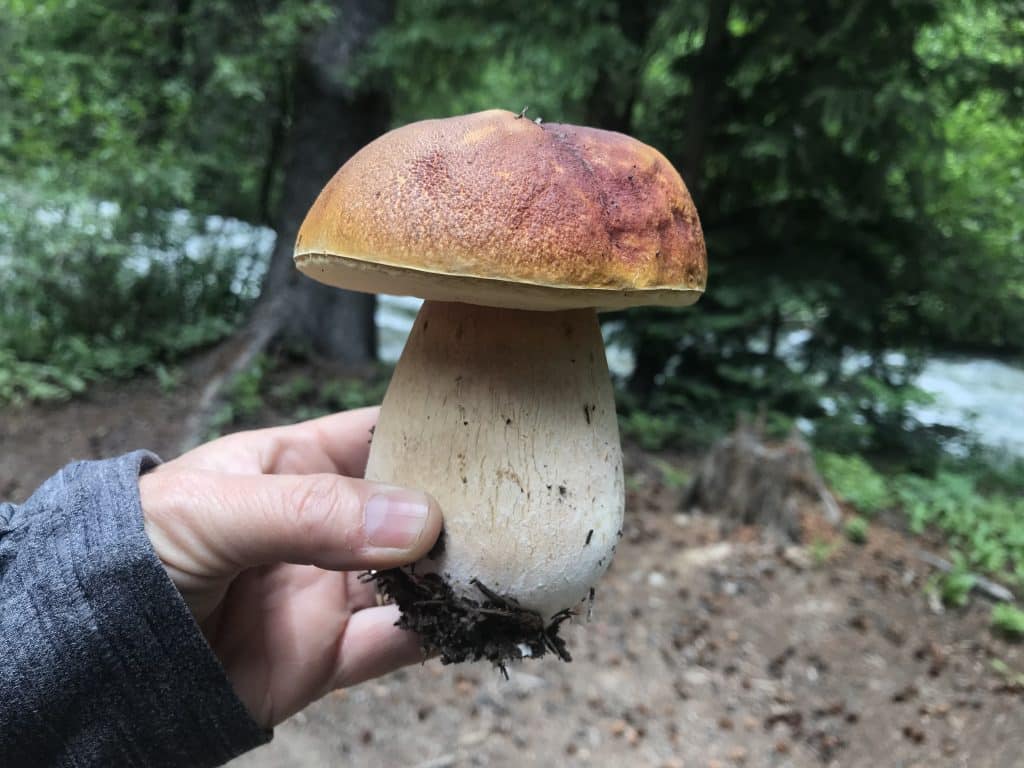Are you intrigued by the idea of wandering through nature, discovering and collecting delicious edibles that grow wild? You’re not alone. Many people find the thought of foraging for mushrooms and wild plants both exciting and a bit daunting—after all, knowing what’s safe to eat is crucial.
Kristen and Trent Blizzard have turned this passion into a lifestyle, authoring “Wild Mushrooms: A Cookbook and Foraging Guide” after about 10 years of mushroom foraging experience in the Vail Valley.
This guide will take you on a journey through Vail’s lush landscapes, uncovering the secrets to finding porcinis, morels, chanterelles, and other edible delights hidden among the forests.
We’ll help demystify which mushrooms are safe to eat—the Blizzards mastered this skill over time—and share insights on when and where to find them. Your next outdoor adventure could be your most delicious yet.
Ready? Let’s start exploring.
Key Takeaways
- The best time to forage in Vail is from April through October, with the mushroom season peaking around August. Morels thrive especially well in areas affected by wildfires.
- Porcini, chanterelles, morels, hawk’s wing, saffron milk cap (MilkyCaps), puffballs, corals, oyster mushrooms, and wood ears are some of the edible wild plants and mushrooms you can find in Vail.
- Always double-check your finds to ensure they’re safe to eat. Not being 100% sure about a mushroom can lead to risky mistakes. It’s also important to carry essential tools like a mushroom bag or basket and a guidebook for accurate identification.
- Guided tours such as Jeep Tours offered by Mountain Wolf Jeep Adventures or Walking Mountains Science Center Hiking Tours provide expert insight into safely finding edible mushrooms around Vail.
- Mushroom festivals like the Eagle Mushroom & Wild Food Festival offer workshops and sessions led by experts where enthusiasts can learn more about mycology—the study of fungi—and get tips on identifying different types of mushrooms.
Edible Wild Plants and Mushrooms in Vail

Explore the abundance of edible wild plants and mushrooms in Vail, including porcini, chanterelles, morels, hawk wings, and other unique varieties. Discover the rich diversity of natural foraging options that await those exploring the picturesque landscapes of Vail.
PorciniPorcini mushrooms, known scientifically as Boletus edulis, are a favorite among mushroom hunters in Vail. These fungi have a rich, earthy flavor that makes them sought after by chefs and food enthusiasts alike.
They grow in the wild forests of Vail, thriving under certain types of trees like pines. Mushroom lovers prize porcini for their thick stems and large brown caps.
Finding porcini can feel like hitting the jackpot due to their delicious taste and versatility in cooking. Whether you’re sautéing them for a pasta dish or adding them to a hearty stew, porcini mushrooms add depth and flavor that’s hard to match.
Their popularity isn’t just because they’re tasty; it’s also because they signal a healthy, symbiotic relationship between mushrooms and trees in Vail’s ecosystems. Happy hunting!
Chanterelles
Chanterelles stand out among the mushrooms you can find in Vail. They’re not just any mushroom; they are prized for their unique flavor, often described as slightly peppery with a hint of fruitiness.
These golden delights are commonly found under specific trees in Vail, making them a sought-after find for those exploring the woods. Eagle Mushroom & Wild Food Festival is a great place to dive deeper into how chanterelles make culinary dishes extraordinary.
To locate these golden chanterelles, look around areas dominated by certain tree species – an exciting adventure that combines the thrill of the hunt with the beauty of nature. This quest not only satisfies your ancestral hunter-gatherer gene but also promises a delicious payoff.
Next up, let’s talk about Morels, another fungus favorite that thrills mushroom hunters in Vail.
Morels
Shifting focus from chanterelles, we dive into the world of morels, a true treasure for mushroom hunters in Vail. These mushrooms are not just sought after for their unique taste but also for the thrill of the hunt.
Morels thrive especially well in areas affected by wildfires. The Sylvan wildfire in 2021 turned Eagle into a hotspot, producing hundreds of pounds of these prized fungi.
Hikers and adventurers take note: morel season adds an exciting chapter to your outdoor escapades. Unlike other mushrooms, morels have a distinctive appearance with their honeycomb surface.
They can be found lurking near cottonwood trees or areas with disturbed soil—a year after a wildfire has swept through. This makes them both a challenge and a delight to find, offering an unmatched dopamine response when you spot one peeking out from under the foliage.
Hawks Wing
Hawk’s Wing mushrooms are easy to spot, making them great for beginners. They have a unique look that reminds people of a hawk’s wing. You’ll find these mushrooms standing out because of their distinct texture and patterns.
The thrill of finding Hawk’s Wing adds excitement to the adventure of mushroom hunting in Vail. It’s crucial, though, to always double-check your findings. Even though they’re beginner-friendly, mixing up mushrooms can be risky.
If you’re not 100% sure what you’ve found, don’t eat it. Safety first—make sure you know exactly what ends up in your basket.
MilkyCapsSaffron milk cap mushrooms, also known as MilkyCaps, are part of the sought-after edible wild plants and mushrooms you can find in Vail. These vibrant orange-capped fungi are a must-know for foragers exploring the area.
However, it’s crucial to be aware that while they’re highly regarded for their culinary value, like all foraged produce, proper identification is paramount to avoid any potential risks associated with poisonous mushrooms.
So take time to learn and recognize these alluring MilkyCaps before embarking on your wild mushroom adventure in Vail!
Puffballs
Puffballs, a type of mushroom, appear in Vail from mid-July to September, at elevations exceeding 10,000 feet. Foragers should exercise caution and identify puffballs thoroughly before consuming them.
These elusive mushrooms form part of the diverse range of edible wild plants and mushrooms found in Vail’s forests—a chance for foragers to connect with nature and embrace ancestral hunter-gatherer activities.
Foragers can look for puffballs along with other types of mushrooms that could be located in unexpected areas within the forest. Local knowledge or guided tours can aid in identifying these mushrooms accurately and safely.
Corals
Moving on from the unique Puffballs, Vail also offers a diverse array of Corals. While not mentioned in this context, tourists visiting Vail can explore and discover a variety of coral species during their foraging adventures.
With the vast natural habitat and rich diversity of flora in the area, corals present an exciting addition to your exploration, enriching your foraging experience with their distinctive characteristics.
Keep an eye out for these fascinating corals as you traverse the picturesque landscapes of Vail.
OysterOyster mushrooms can be found in Vail, Colorado between mid-July and September above 10,000 feet. The Blizzards caution foragers to be able to identify oyster mushrooms and other edible mushrooms with 100% certainty before consuming them.
Oyster mushrooms are one of the many edible mushroom varieties found in Vail, along with porcini, chanterelle, and morels.
Guided Mushroom Tours in Vail provide a great way to delve into the wild foraging experience while ensuring safety and education about different mushroom varieties. You might want to check out where these tours take you next!
Wood Ears
Wood Ears, also known as cloud ears or tree ears, are edible mushrooms found in Vail, Colorado. These fungi have a gelatinous and wrinkled appearance with a delicate texture. They can be typically spotted on dead and decaying wood, especially on elderberry trees.
Wood Ears are often used in Asian cuisine for their unique crunchy texture and ability to absorb flavors from the dishes they’re cooked in.
These versatile mushrooms are rich in antioxidants and iron, making them not only flavorful but also nutritious. When foraging for Wood Ears in Vail, keep an eye out for these distinct dark-brown to black-colored fungi growing near creeks or moist areas within the forest.
When to Forage in Vail

Foraging in Vail is optimal from April to August, peaking through October. This period marks the mushroom hunting season and presents abundant opportunities to find diverse edible wild plants and mushrooms.
Favorable foraging conditions are also found in burn areas following wildfires, where morel mushrooms flourish in the years after a burn. Utilize Burn Maps to locate suitable foraging spots within these areas post-wildfire activity, ensuring a fruitful and rewarding foraging experience.
Where to Forage in Vail

“Vail offers diverse foraging opportunities, from pine forests to talus slopes and meadows bursting with mushrooms – discover the best spots for a fruitful hunt! Ready to uncover Vail’s hidden treasures? Let’s dive in.”
Elevation consideration
Plan to forage between 7,500 and 10,000+ feet in Vail. Look for mushrooms on north-facing slopes and in coniferous and hardwood forests. The best time to find porcini, chanterelle, oyster, hawk’s wing, saffron milk cap, shrimp russula, and puffballs is from mid-July through September.
Consider these factors when seeking out edible wild plants and mushrooms in Vail – Porcini..
Identifying tree species
Specific tree species are linked to different types of mushrooms, such as morels, king boletes, golden chanterelles, and oyster mushrooms. Burn areas from wildfires can yield abundant morel mushrooms in the years following a burn.
Utilize resources like Burn Maps to track suitable areas for foraging. Be mindful of tree species and their associations when seeking out edible wild plants and mushrooms in Vail.
Effect of recent wildfire activity
After identifying tree species, it’s crucial to consider the impact of recent wildfire activity when foraging in Vail. For instance, morel mushrooms tend to flourish about a year after a wildfire.
The 2021 Sylvan wildfire in Eagle resulted in an abundant yield of morels, with hundreds of pounds harvested. However, foragers need to exercise caution and properly identify edible mushrooms as well as distinguish them from potentially harmful varieties.
Understanding the specific effect that recent wildfires have had on the local ecosystem is vital knowledge when venturing out for mushroom-hunting adventures.
White River National Forest and other popular spots
White River National Forest, a favorite foraging spot, beckons with an abundance of edible wild plants and mushrooms. Vail Mountain, Beaver Creek Mountain, Vail Pass, Shrine Pass… these spots offer rich pickings for mushroom hunters.
Permits are mandatory in White River National Forest – consider guided jeep tours to enrich your foraging experience.
Ample opportunities await at popular spots like Tennessee Pass and the Black Lakes region. Remember that knowledge is key; familiarize yourself with elevation considerations and recent wildfire impacts before venturing out into this natural treasure trove.
Guided Mushroom Tours in Vail

Embark on Jeep Tours to explore Vail’s diverse fungi with knowledgeable guides. Join Walking Mountains Science Center Hiking Tours for an immersive mushroom-hunting experience in the heart of nature.
Jeep Tours
Kristen and Trent Blizzard, the seasoned guides of Mountain Wolf Jeep Adventures, offer thrilling jeep tours for mushroom foraging in Vail. Join their expert-led expeditions to navigate the stunning terrain and discover abundant porcini, chanterelles, and morels — an unforgettable experience for nature enthusiasts.
For a knowledgeable journey into Vail’s natural bounty, count on Timberline Tours or Sage Outdoor Adventures’ experienced guides who will whisk you away on exhilarating journeys through the wilderness.
Mushroom hunters can elevate their adventure by embarking with these reputable companies to explore Vail’s bountiful flora. With trusted guides at your side, you’ll delve deep into the forests and meadows where these delectable treasures lurk.
Walking Mountains Science Center Hiking Tours
Explore the breathtaking beauty of Vail’s wilderness with Walking Mountains Science Center Hiking Tours. Led by knowledgeable guides, these tours offer an enriching foraging experience as you learn to identify and gather edible wild plants and mushrooms in their natural habitat.
Immerse yourself in the stunning surroundings while discovering a wide array of flora unique to this region. Enjoy an educational and memorable adventure, gaining valuable insights into the diverse ecosystems and rich biodiversity of Vail.
As you embark on these captivating hiking tours, seize the opportunity to discover firsthand the wonders of nature in Vail’s pristine landscapes. Engage with experienced guides who will lead you through enchanting trails teeming with delicious finds waiting to be unearthed.
With Walking Mountains Science Center Hiking Tours, every step is an invitation to delve into nature’s bounty and uncover its hidden treasures.
Mushroom Festivals in Vail

Explore the vibrant Eagle Mushroom & Wild Food Festival, offering workshops and foraging expert sessions. Engage in the Telluride Mushroom Festival for a deep dive into mycology through lectures, cooking demonstrations, and mushroom identification walks.
Eagle Mushroom & Wild Food Festival
Explore the exciting world of mushrooms at the Eagle Mushroom & Wild Food Festival in Vail, Colorado. Discover an array of morel species and saffron milk caps while learning about their scientific, medicinal, and culinary significance.
Engage with local mycological societies to enhance your knowledge and network with fellow enthusiasts for a truly immersive experience in the captivating world of fungi.
Take part in educational sessions and guided forages led by experts to delve into the habitats, identification, and benefits of these natural treasures. This festival offers a unique opportunity to deepen your understanding of mushrooms while enjoying the picturesque surroundings of Eagle County.
Telluride Mushroom Festival
Before exploring the Telluride Mushroom Festival, it’s crucial to note that this event is connected with other mushroom festivals in Vail, Colorado. The festival revolves around the exploration and foraging of wild, edible plants and mushrooms in the Vail area.
Coupled with expert insights from experienced foragers like Kristen and Trent, authors of “Wild Mushrooms: A Cookbook & Foraging Guide,” visitors are sure to gain valuable knowledge about identifying and enjoying these natural treasures.
Moreover, tourists attending the festival can expect a deep dive into specific edible mushrooms such as Porcini, Chanterelles, Morels, Hawks Wing among others found in Vail. Aspiring foragers will also learn about when these delectable findings are most abundant throughout the year – typically beginning in April through October and peaking during August – ensuring an enriching experience at Telluride Mushroom Festival.
Tools for Mushroom Hunting
Ensure you have the essential tools before heading out to forage:
- Mushroom bag or basket: Carry a sturdy bag or basket to collect your finds without damaging them.
- Mushroom knife: Use a sharp knife with a curved blade for clean cuts and easy harvesting.
- Guidebook: Take along a reliable guidebook to identify mushrooms accurately and ensure safety.
- Raincoat: Prepare for unexpected weather by carrying a waterproof jacket or poncho.
- Map, compass, or GPS: Stay oriented in the wilderness using navigation tools to find and return from foraging spots.
- Hiking boots: Wear sturdy, waterproof boots with good traction for safe and comfortable treks.
- Bear bells: Alert wildlife of your presence by attaching bear bells to your clothing to prevent accidental encounters.
So, there you have it—abundant, flavorful treasures await in Vail’s wilderness. Discover a variety of edible wild plants and mushrooms with ease. Embrace the simplicity and joy of foraging while exploring nature.
Ready to embark on your foraging adventure? Experience the thrill of finding culinary delights in the great outdoors. Uncover a world of natural bounty waiting to be explored in Vail!
FAQs
1. What can I find while foraging in Vail?
In Vail, you’ll stumble upon a variety of edible wild plants and mushrooms — think burn morels, lobster mushrooms, puff balls (lycoperdon perlatum), and even the delightful chantarelles. Not to mention greens like curly dock, dandelion (taraxacum officinale), and prickly lettuce!
2. Are there any berries I can pick?
Absolutely! The woods and fields around Vail are bursting with berries during the right season. You might find thimbleberries, saskatoons, chokecherries, strawberries, blueberries…the list goes on. Just make sure you know what you’re picking.
3. Where can I learn about safe foraging practices?
The Walking Mountain Science Center offers classes on identifying edible wild plants and mushrooms safely—because it’s crucial not to mix up your finds with something harmful.
4. Is foraging for everyone?
For sure! Whether you’re trekking through lush forests or exploring local bushes for artichoke hearts akin flavors—it’s an adventure anyone can enjoy. Remember though; some knowledge is needed before you start picking away.
5. Can I find medicinal mushrooms in Vail?
Yes! Amongst the treasure trove of fungi in Vail are medicinal varieties that locals swear by—for their health benefits that go beyond being just food.
6. When is the best time to go foraging in Vail?
Spring through fall is prime time—each season brings its unique finds from greens early in the year to a diverse range of mushrooms as months warm up.



